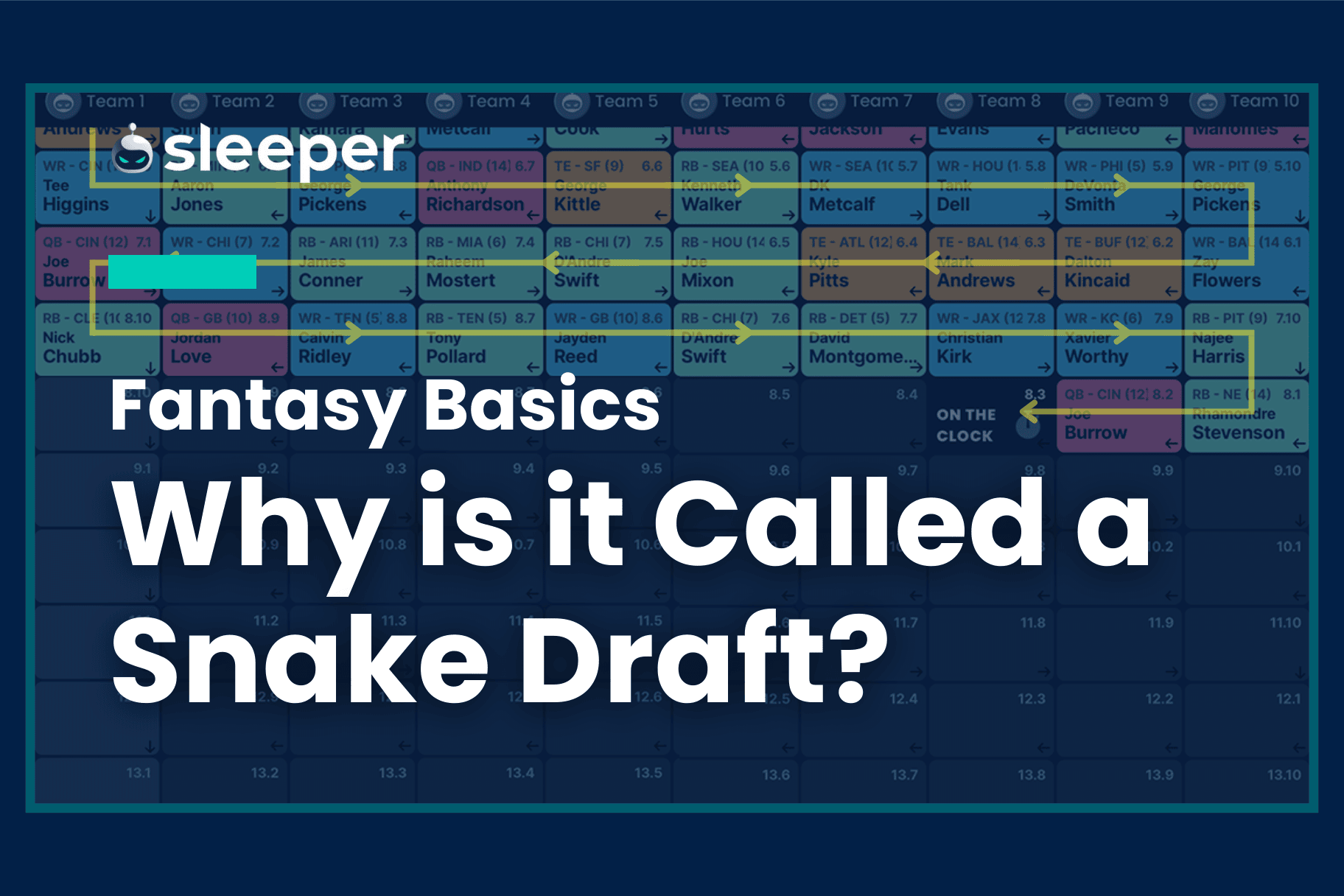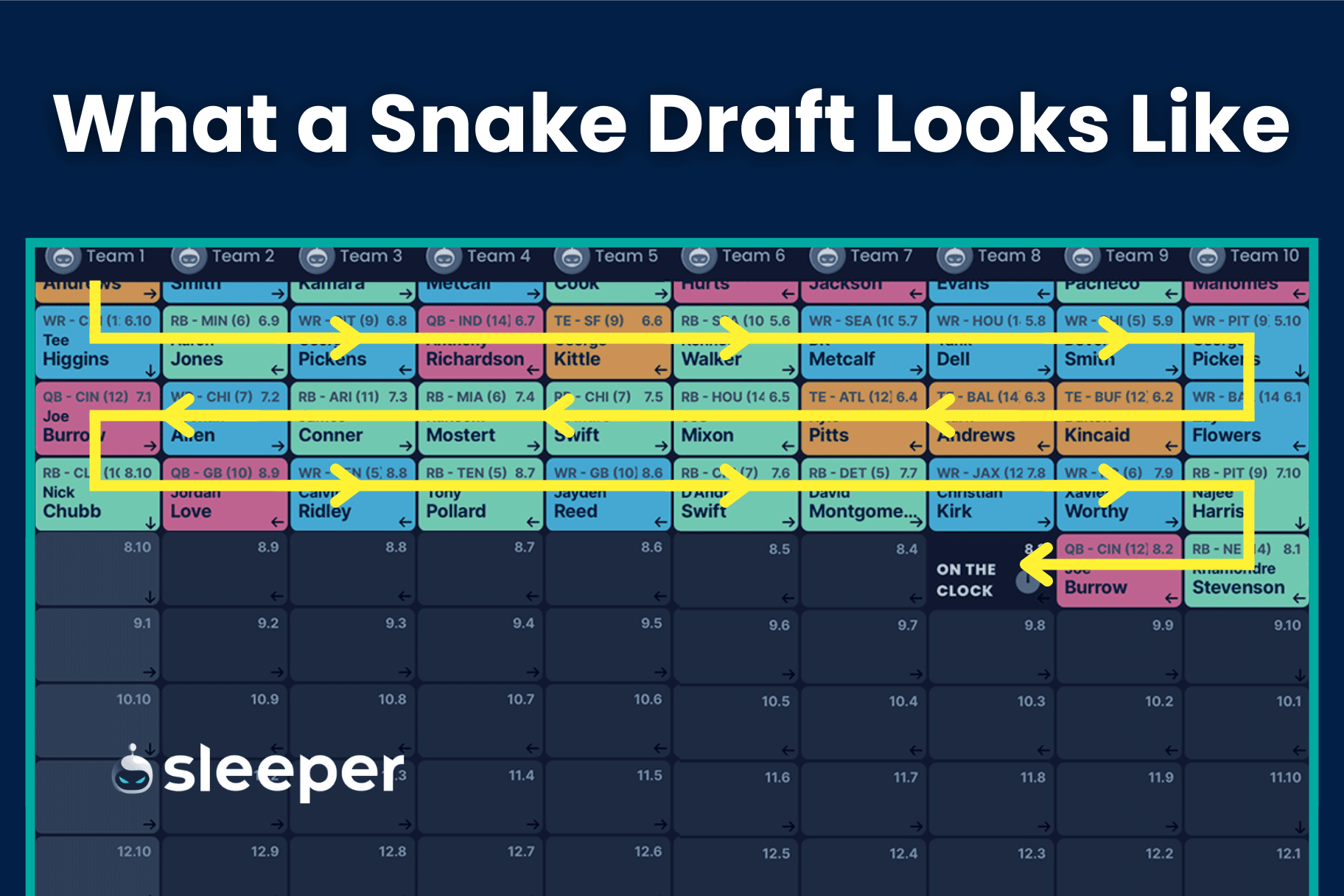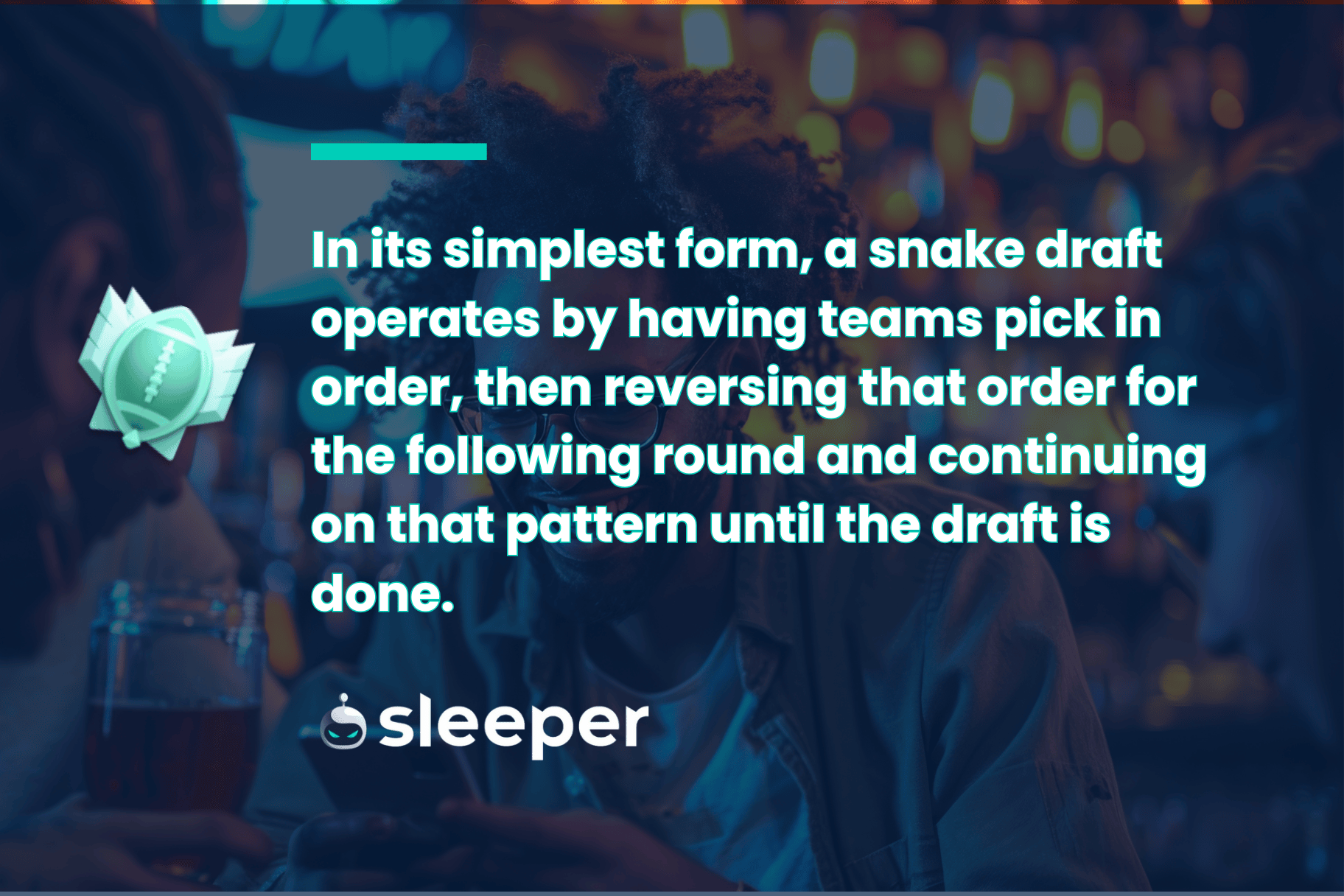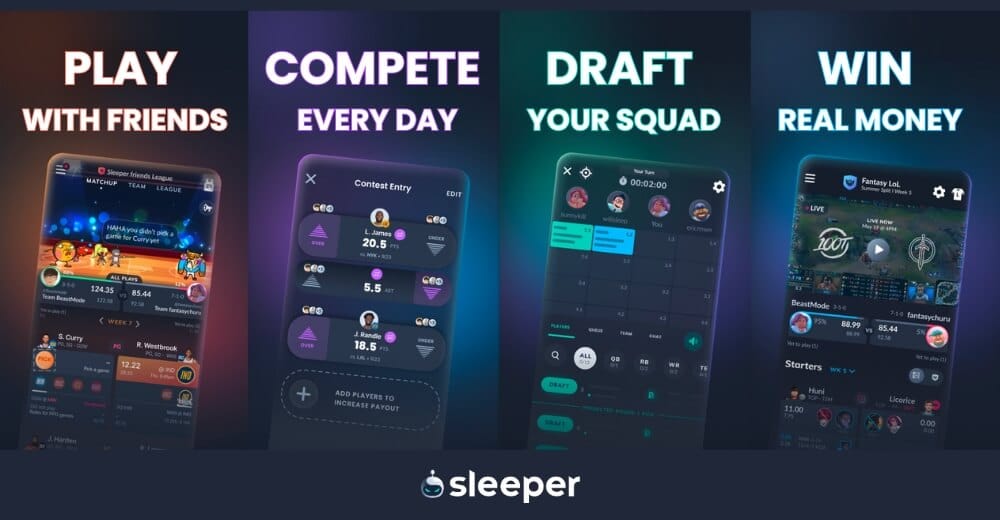We walk you through the details of fantasy snake drafts, explaining what they are and offering tips to help you craft a successful draft strategy.

Fantasy football drafts are the foundation for every league, no matter the size or format. There’s one kind of draft that has been prevalent for ages and is still the most widespread, default across most platforms: the snake draft.
As with its namesake, you want to be cautious and wise in your approach, or else you could wind up with a snake-bitten season. Read on for all you need to know about snake drafts and how best to tame them so you can unleash the venom on your fantasy football foes.
How Does a Snake Draft Work?
In its simplest form, a snake draft operates by having teams pick in order, then reversing that order for the following round and continuing on that pattern until the draft is done. Like a snake, its curves alternate from head (the first pick) to tail (the last one).
For example, if you’re in a 12-team league and picking first, you’ll watch as the rest of the league makes its picks before you get to go again with the last pick of the second round. You’ll then kick off the third round (so you’ll make consecutive picks) and then wait again until the end of the fourth.

Different pick slots could yield different strategies, given that if you have a lengthy gap between selections, certain players or stars of a certain tier at a position that you may want to target could be long gone by the time it's your turn again.
How to Craft a Snake Draft Strategy: 4 Tips
What’s the best way to approach your snake draft? Follow these steps:
1. Plan Accordingly to Your Draft Position
Draft order can mean everything in snake drafts. If you have an early or late round pick, it might make you reach too soon for certain players out of fear of missing them during the lengthy wait you'll face between picks.
One way to combat the unpredictability of long waits is to make your own cheat sheet that lists players in order by position and breaks them into tiers, so that you can segment the player pool accordingly. That way, when it’s your time to pick, you’ve already narrowed the options.
Check out Sleeper's 2024 tiered positions rankings for assistance:
You should have an especially narrowed view of your first-round pick based on your draft position before the draft begins. That will set up your strategy for the rest of the picks that follow.
2. Complete Mock Drafts
Sleeper, like many other platforms, offers a robust mock draft platform, where you can effectively rehearse for your league’s actual draft. Mocks are unlikely to mimic your league’s draft pick for pick, as there’s always a manager in every league whose selections upset the natural expected order of things.
But by doing mock drafts, you can at least get a general sense for which players will be available and which ones will not when it’s your turn to go.
You can even mock for the precise pick you have in the draft order to give you the clearest perspective going into your league’s big night.
3. Check Recent Stats and News
Being up to date on player statuses entering the season is every manager’s responsibility. Nobody wants to unknowingly and regretfully select the player who sprained his ankle in the preseason and will miss 4-6 weeks. Stay in the know so you can avoid making a draft day sin.
Use the Sleeper app to access injury news, player rankings and a wide range of handy Sleeper Minis — including data and research tools — to shore up your fantasy knowledge and prepare you for draft day.
4. Know Your League’s Settings
Is your league a point-per-reception (PPR) league, or do receptions not matter? How much are passing touchdowns worth? These are the kinds of questions you should have answered before you draft, as they’ll factor into your decisions in a big way.
PPR (or half-point PPR) leagues mean you’ll want to prioritize pass-catchers (and add value to pass-catching) running backs, while if passing touchdowns are worth the same as rushing and receiving TDs, it’ll alter your quarterback strategy.

Auction vs. Snake Draft: The Differences
In a snake draft, so much comes down to the fortune (or misfortune) of where you’re picking in the order. If you have the seventh pick, you can stop dreaming of Christian McCaffrey leading your backfield. Simply put, the only players available to you are the ones still on the board by the time it’s your turn to pick.
In auction drafts, however, every player is available to every manager — as long as you can afford it. Every manager starts with the same budget (the default option on Sleeper is $100, but some sites will give managers $200; it’s all relative anyway), and players are allocated through a live bidding process.
If there’s a player or two you must have, you can blow your budget that way. Or if you want to opt for balance, you can watch as others outbid each other for the elite stars while you collect quality players across the board at lower price points.
Regardless of your strategy, your roster is not contingent on your place in a draft order, as it is with snake drafts.
Frequently Asked Questions
How many picks do I get each round in a snake draft?
Typically, it’s one. Every team in the league picks once in each round. That said, if your league allows for draft picks to be traded, you could wind up with multiple picks in a given round (and potentially none in another, depending on the parameters of your deal).
Who gets the first pick in a snake draft?
That comes down to your commissioner and how he or she decides to determine the draft order. Whether it’s a random generator or based on the previous season’s record or comes down to some sort of competition, the order should be set prior to the draft — and a good commissioner will give you ample time to prepare knowing exactly where you’ll be picking.
Which picks does each draft slot have in a snake draft?
That all depends on how many teams are in your league and how many rounds your draft will run. But using the example of a 12-team league and a 16-round draft, you’ll wind up with:
1st pick: 1, 24, 25, 48, 49, 72, 73, 96, 97, 120, 121, 144, 145, 168, 169, 192
2nd pick: 2, 23, 26, 47, 50, 71, 74, 95, 98, 119, 122, 143, 146, 167, 170, 191
3rd pick: 3, 22, 27, 46, 51, 70, 75, 94, 99, 118, 123, 142, 147, 166, 171, 190
4th pick: 4, 21, 28, 45, 52, 69, 76, 93, 100, 117, 124, 141, 148, 165, 172, 189
5th pick: 5, 20, 29, 44, 53, 68, 77, 92, 101, 116, 125, 140, 149, 164, 173, 188
6th pick: 6, 19. 30, 43, 54, 67, 78, 91, 102, 115, 126, 139, 150, 163, 174, 187
7th pick: 7, 18, 31, 42, 55, 66, 79, 90, 103, 114, 127, 138, 151, 162, 175, 186
8th pick: 8, 17, 32, 41, 56, 65, 80, 89, 104, 113, 128, 137, 152, 161, 176, 185
9th pick: 9, 16, 33, 40, 57, 64, 81, 88, 105, 112, 129, 136, 153, 160, 177, 184
10th pick: 10, 15, 34, 39, 58, 63, 82, 87, 106, 111, 130, 135, 154, 159, 178, 183
11th pick: 11, 14, 35, 38, 59, 62, 83, 86, 107, 110, 131, 134, 155, 158, 179, 182
12th pick: 12, 13, 36, 37, 60, 61, 84, 85, 108, 109, 132, 133, 156, 157, 180, 181
If you cross-reference those pick slots with readily available ADP (average draft position) data, it can also help inform you about who, roughly, should be available when it’s your turn to pick going into your league’s draft.
It’s Time To Become A Snake (Draft) Charmer
Test out your newfound knowledge of snake drafts by playing Sleeper’s free season-long fantasy football game. You can sign up on the website or by downloading the app.
Sleeper offers two kinds of snake drafts: the more traditional version and the third-round reversal (3RR). The latter presents a tweak on the snake draft, where the direction of the draft reverses at the start of the third round.
In short: The team with the first overall pick won’t get two selections in a row to end the second round and start the third as it would in a typical snake format. Instead, the last team to pick will get the first pick in the third round, and then the draft will continue as a regular snake draft from that point forward. It’s a small change that could make the draft outcome a bit more balanced and offer the teams later in the order the chance to land better talent.
In addition to 3RR, Sleeper offers no ads, a smooth user experience and social chat that no other platform can match, allowing for easy communication — and plenty of trash talk — between league members.




